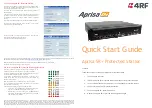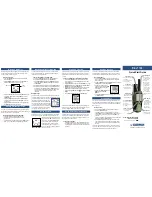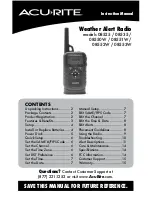
Testing and calibration:
The board is now complete except for installing the ICs. Give the BFO trimmer (CT1) about a ¼ turn from its
factory setting. If you look closely in the trimmer hole, you will see an arrow at one end of the screwdriver
slot. When the arrow points towards the flat side of the body, it is a maximum capacitance. When it points to the
round end opposite the flat end, it is at minimum.
If you have some 1/2” 4-40 screws and nuts or threaded spacers, put these in the four corner mounting holes to
rise the board off your bench. Otherwise, clean the work space of wire clippings and solder blobs. Wire up the
power jack and BNC jack to the board. Wrap a piece of tape around the leads of the power connector so there isn't
a chance the B+ can short to something on the board as you flop it around to work on.
Initial tests:
Connect a 9 to 12 volt power source to the board and use the power switch on the board to turn it on.
●
Check for proper voltages from the regulators. There should be +5 volts on pin 14 of U7 and +6 volts on
pin 8 of U5.
●
If the voltages are correct, disconnect power and install the MEGA48 processor into the U4 socket.
●
Power up the board again and the power up sequence should be seen on the display. 1) all segments light
for a second, 2) 40, 30 or 20 will be shown depending on which band the band select switch is set to and
then 3) the initial operating frequency.
●
You can now test the tuning and Menu switch for proper operation. Refer to the operating instructions.
●
Remove power again and install the rest of the ICs.
●
U1, LM386 / U2, LM358 / U3, SA612A / U5, SA612A / U7, 74AC02 or 74HC02
●
Connect an antenna to the BNC jack and restore power.
●
You should now be able peak the receiver input tuning and to hear stations. (Attach the nylon spacer
shaft extender to the variable cap to make it easier to adjust.)
Transmitter testing:
Turn the power off and then disconnect the antenna and connect up a suitable QRP power meter and dummy load. Make
sure the TUNE / Operate switch is in the Operate position and the coax / BLT switch is in the Coax position.
Plug in a paddle or straight key. If using a paddle, you can hold the dash paddle closed when turning the power
on to set the rig to straight key mode. Then the dot paddle will key the transmitter on and off.
You can now turn the power back on and key the transmitter. Power output depends on supply voltage. With a 9.0 V
supply, power out should be about 2.5 watts on all bands. With 12.0 V supply power out should be between 4.5 and
5 watts on all bands.
Tweaking power output:
Power output is affected by the spacing of the turns on the input side coil for the low pass filter. This would
be L6, L8 or L10 for 40, 30 and 20 respectively. If power output is too high, move some of the turns closer
together. If it is too low, spread the turns out as best can be done. If the power out is much lower then
expected, this is usually due to have an extra turn on the core or a very loosely wound one. Although some times
the problem is simply a power meter which is not very accurate at these power levels.
SWR bridge testing:
Set the TUNE / Operate switch to TUNE, disconnect the dummy load and transmit. The LED should light brightly. Now
reconnect the dummy load and transmit again. The LED should be off or very dim.
BLT testing:
The Balance Line Tuner is more easily tested once the board is wired up into the enclosure, but you can do that
now if you like. If there is a problem it will be easier to fix with the board out of the case.
First install the wires to the board to the output of T1 which will connect to the binding posts. Now connect the
BNC jack to these wires. It doesn't matter which one is ground. Attach the shaft extenders and knobs to the
variable caps to make then easier to adjust.
Connect your dummy load and also your power meter if you like. Set the Tune/operate switch to Tune and the
Coax/BLT switch to BLT. Set the Hi Z/ Low Z switch to Low Z.
Refer to the operating instructions later in the manual for how to use the BLT. Tuning is very touchy and it
takes some practice. Doing this now into a dummy load is a good way to not only verify operation, but to get that
practice.






































